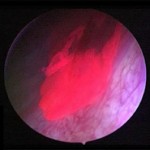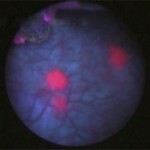Editorial: Does HAL assistance improve outcomes in patients who receive postoperative intravesical therapy?
There is growing evidence that hexaminolevulinate (HAL) fluorescence cystoscopy increases detection of bladder cancer at the time of transurethral resection of bladder tumours (TURBT) and that this results in lower recurrence rates [1, 2]. One limitation in many prior studies was the lack of standardisation about the use of immediate postoperative chemotherapy, which has been shown to reduce recurrence in patients with non-muscle-invasive bladder cancer [3]. This raises the question of whether the benefit of HAL in reducing recurrences would be eliminated if patients did in fact receive postoperative intravesical chemotherapy, which would help eradicate any missed residual tumour.
There have been several studies that attempt to bring clarity to this issue. A study by Geavlete et al. [4] randomised 362 patients suspected of having bladder cancer to HAL vs white-light (WL) TURBT with a single postoperative mitomycin C instillation given in all cases. The authors found that the recurrence rate at 3 months was lower in the HAL group (7.2% vs 15.8%) due to fewer ‘other site’ recurrences when compared with the WL group. There continued to be an advantage for the HAL group with lower 1- and 2-year recurrence rates compared with the WL group (21.6% vs 32.5% and 31.2% vs 45.6%, respectively). The study did not stratify patients specifically to those with low-grade non-invasive tumours but patients with single tumors had a trend toward less recurrence (23.3% vs 35.3%, P = 0.064).
Grossman et al. [2] published the long-term follow-up for 551 patients enrolled in a prospective, randomised study of HAL vs WL for Ta or T1 urothelial bladder cancer with similar rates of intravesical therapy in the two groups (46% and 45%, respectively). They found that the median time to recurrence was 9.4 months in the WL group and 16.4 months in the HAL group (P = 0.04) but they did not report specifically on patients who received postoperative intravesical therapy. A meta-analysis of raw data from prospective studies on 1345 patients with suspected bladder cancer evaluating HAL-assisted cystoscopy vs WL found that both patients with low- and high-risk disease had statistically significant lower recurrence rates [1]. This meta-analysis was unable to stratify based on use of postoperative intravesical therapy.
O’Brien et al. [5] performed a randomised prospective study of HAL-assisted vs conventional WL TURBT, with all patients scheduled to get a single treatment of postoperative intravesical mitomycin C. There were 86 and 82 patients with cancer in the HAL and WL groups who completed the 12 months follow-up, respectively. In this study, 63% and 77% of the HAL and WL patients received mitomycin C, respectively. There was an increased detection of carcinoma in situ (CIS) in the HAL group (26% vs 14%) but no significant difference in recurrence at 3 and 12 months. When stratifying by low-grade tumours, the 3-month recurrence rates for HAL and WL were 19% vs 9% and at 12 months were 16% vs 22%, so that no significant differences were noted but the study was not powered to evaluate this subgrouping.
What can be concluded then about whether HAL assistance improves outcomes in patients who receive postoperative intravesical therapy? It appears the results are inconclusive and this is not surprising. The risk reduction of postoperative intravesical chemotherapy is primarily limited to patients with a single low-grade papillary tumour and one would need to treat 8.5 patients with peri-TUR chemotherapy to prevent one recurrence [3]. The benefits of peri-TUR chemotherapy in patients at intermediate- and high-risk are not well established [6]. Most of the studies of HAL-assisted TUR have not treated with postoperative intravesical therapy systematically. The studies that have tried to uniformly give postoperative therapy have not been sufficiently powered to evaluate those patients most likely to benefit, namely low-grade non-invasive cancer. As such, one cannot determine whether the benefit of potentially detecting additional low-grade tumours by HAL in patients with low-risk disease could be matched by postoperative intravesical therapy and such a study would require a very large number of low-grade solitary papillary tumours. However, it would minimise the benefits of HAL to focus on the benefit in the lowest risk patients. A meta-analysis of randomised trials found that HAL reduced the risk of recurrence independent of level of risk, such that there was reduced recurrence in patients with CIS, T1 and high-grade disease [1]. These are patients for which immediate postoperative intravesical therapy has shown minimal benefit and for which the benefit of HAL cannot be explained away. Furthermore a small but meaningful number of low-risk patients can be found to have intermediate- or high-risk disease, which would change their subsequent management [4]. As such if one had to choose between approaches rather than apply both, the use of HAL would appear to result in a greater benefit in managing patients with bladder cancer.
Yair Lotan
Department of Urology, UT Southwestern Medical Center at Dallas, Dallas, TX, USA
References
- Burger M, Grossman HB, Droller M et al. Photodynamic diagnosis of non-muscle-invasive bladder cancer with hexaminolevulinate cystoscopy: a meta-analysis of detection and recurrence based on raw data. Eur Urol 2013; 64: 846-54
- Grossman HB, Stenzl A, Fradet Y et al. Long-term decrease in bladder cancer recurrence with hexaminolevulinate enabled fluorescence cystoscopy. J Urol 2012; 188: 58–62
- Sylvester RJ, Oosterlinck W, van der Meijden AP. A single immediate postoperative instillation of chemotherapy decreases the risk of recurrence in patients with stage Ta T1 bladder cancer: a meta-analysis of published results of randomized clinical trials. J Urol 2004; 171: 2186–2190
- Geavlete B, Multescu R, Georgescu D, Jecu M, Stanescu F, Geavlete P. Treatment changes and long-term recurrence rates after hexaminolevulinate (HAL) fluorescence cystoscopy: does it really make a difference in patients with non-muscle-invasive bladder cancer (NMIBC)? BJU Int 2012; 109: 549–556
- O’Brien T, Ray E, Chatterton K, Khan S, Chandra A, Thomas K. Prospective randomized trial of hexylaminolevulinate photodynamic-assisted transurethral resection of bladder tumour (TURBT) plus single-shot intravesical mitomycin C vs conventional white-light TURBT plus mitomycin C in newly presenting non-muscle invasive bladder cancer. BJU Int 2013; 112:1096–1104
- Kamat AM, Lotan YR. Perioperative intravesical therapy after transurethral resection for bladder cancer. J Urol 2010; 183: 19–20



